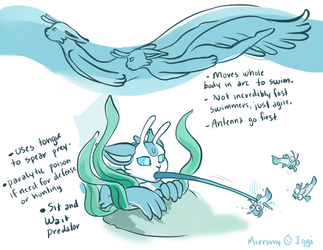Sign In
CloseQuite a wide range of colors is available. The more of a color shown here, the more common it is. This isn't exact but it is a good base, most colors are closely matched to the ones shown. I figured this was a good start for those still wishing to create their own Mirromy.
Skin and Coloration: A Mirromy's rubbery outer skin is located along the shoulders, back, arms, legs, top of the tail, and head of the creature. The color of this flesh is generally limited to a highly saturated color. Exceptions to this rule have been documented, however, indicating that it is possible for the species to also possess pastel, dark, desaturated, or grey colors. In all cases, the most common hues are of red or blue.
Patterns located on the outer skin are highly diverse. Parents and offspring, when compared, are noted to share very few identifiable patterns, though the color of the parent is often passed to the next generation. With regards to markings, the most common are spots or long stripes that occupy the outer skin of the creatures. The inner skin generally remains devoid of any patterning.
The Inner skin, located along the chest, inner thighs, underarms, neck, underside of the tail, face, and stomach, is typically devoid of markings. Coloration of this skin typically consists of a color lighter than the outer skin, though some reversals of this pattern exist. The inner skin is smoother and softer, not unlike that of a human, though scar tissue and genetics can alter the texture. Both outer skin and inner skin are always a different color.
Mirromy eyes are typically a solid highly saturated color with a lighter or darker iris of the same hue. The pupil is malleable while the Mirromy is young and often splits into several sections, if the Mirromy grew up in a dark environment, or remains whole like a human. It is noted that Mirromy eyes are highly reflective, and are able to register visual details in the darkest of places.
The 'gem' located in the center of a Mirromy's forehead is in fact a parietal eye, of sorts. Though not capable of discerning color or detail, it is still capable of registering vague shapes and light in a rounded arc above a Mirromy's head. This photosensitivity helps ensure that predators are not stalking them from behind or above as they hunt on the bottom of a body of water.
Tendrils and tentacles, which adorn a Mirromy's body, follow the same coloration as a mirromy's tail, with outer skin color covering the top and inner skin color covering the underside. An exception has been noted, however, when these tendrils reach a certain length, in which case they terminate in a darker or lighter shade of their inner skin's color. As this is genetically linked to the Mirromy's skin color, the tips have rarely resulted in a different coloration.
Any exposed flesh is a lighter color of the Mirromy's blood, typically red or blue. Unlike most species, this color changes based on the diet of the Mirromy. In most cases, Plant eaters have blue blood and meat eaters have a red blood. Due to the highly variable state of their bodies, however, abundant minerals in a substantially altered diet can cause a mirromy's blood and flesh to warp and alter its color.
Eyes
-All three are typically the same color, though the parietal in most cases is the same color as the scalera (eye white). Scalera is rarely white, rarely a different hue than iris, but most commonly a variation of the iris color. Eye color, though not always, is related to the color of the blood.
Submission Information
- Views:
- 223
- Comments:
- 0
- Favorites:
- 0
- Rating:
- General
- Category:
- Visual / Other




